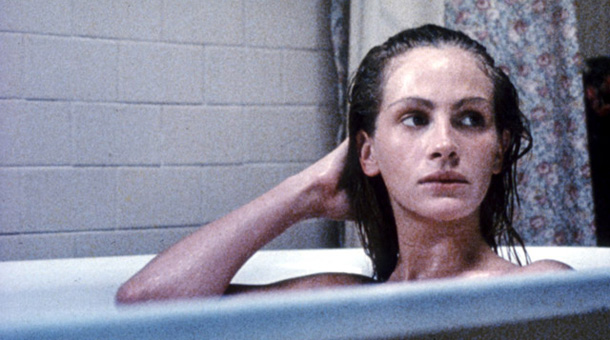
In 1991 Julia Roberts was huge. Probably the biggest movie
star of the year, certainly the biggest female star.
But how do we know it was her who was big, and not just someone lucky enough to star in good
movies? Sleeping with the Enemy.
A film like this is sort of a rite of passage for a rising
star. Michael J. Fox had his, with the incredibly mediocre yet surprise hit The Secret of My Success; ditto Sandra
Bullock’s mega-cutesy While You Were
Sleeping.
I mean, you could argue that Roberts’ smash Pretty Woman owed at least part of its
success to its modern-day fairy tale script and steadying performance by
Richard Gere. Steel Magnolias was
based on an acclaimed play, with fine work by a stellar cast. Flatliners had a pretty nifty concept;
it too was more of an ensemble.
But in Sleeping With
the Enemy, she’s on her own. She has no support from the two male drips
with whom she co-stars, and the story is merely a well-mounted Lifetime Movie-of-the-Week. There is
literally nothing else in the movie that can account for its success. And it
was a success – to the tune of 170 million dollars – ironically the movie that
knocked Home Alone off its number-one
perch after nearly three months (both are Fox films). And it’s for this reason
that I’m including it as my own personal choice for this collection.
And goddamned it if it doesn’t actually work – barely. It’s
all due to Julia: she keeps the whole thing afloat (pun intended; you’ll see
what I mean) with her incomparably empathic performance – you really feel for
her and, most importantly, you just want
her to be happy. In every scene she’s in, every fiber of your investment is
in her; she bends fragility and vulnerability with just the right amount of
spark and spunk. Women want to be her best gal friend and men want to fall in
love with her – everyone wants to rescue her. Few, if any, modern movie starts
possess this innate screen quality; you’d probably have to go all the way back
to Marilyn Monroe for the last time we’ve seen it.
The plot? It’s just a vehicle, pure and simple. Julia’s in a
woefully abusive marriage with a real scumbucket (Patrick Bergin); one night
they go sailing off the coast, and she falls into the water, assumed dead since
she can’t swim. But wait! She’d been waiting for this moment for a long time –
because she’d been taking swim lessons at the Y, and managed to get to shore,
where she can now start a new life, in Iowa! She rents a house that looks like
it was furnished by Restoration Hardware, and forges a friendship in the form
of a chic-mullet sporting local college drama teacher (Kevin Anderson). Romance
inevitably follows, but not so fast – Bergin’s in town, having tracked her down
through location of her ailing mother. He sneaks into her house, knocks her new
beau out and prepares to kill her, but not before she kills him first. She
shoots him a few times, but that still doesn’t keep him from getting up one last time in a post-fake-death
attack.
Sleeping came out
during of wave of films that fit in the “Don’t rust your lover” subgenre,
essentially begun by the surprise success of 1987’s Fatal Attraction. You know the type – everything seems normal, but then, the One You
Trusted turns out to be a real whacko, all leading up to the inevitable
gunplay, and the aforementioned fake-death. But Sleeping cuts to the chase early on – the husband is revealed as
the whack within the first ten minutes. That’s because the film follows another
subgenre popular in the early 90s: the “Go to a rustic, pastoral place and
you’ll find true love and happiness” subgenre. (Doc Hollywood, City Slickers) Well, she does, and then we get those
associated clichés: the carnival scene, the first-date dinner scene, the music
montage, etc. Sleeping couldn’t be
more commercially cobbled – it plays like a perfect early 90s timepiece what
with its timely tropes.
But despite
many dated elements (including the men’s hair and Bergin’s villainous
moustache), it holds up as well as it could, again due to Roberts. In fact, there’s
not a whole lot of difference between the sensationalism in this as compared to
that in the recent release The Girl on
the Train, with both films sharing a rescuing, lead female performance. It
just shows how a healthy dose of star power can equal any number of
screenwriters, any amount of special effects, any budget.
And in the case of Roberts, I’m not kidding. Her salary
throughout the nineties kept increasing until, in 2000, she became the first
woman to net 20 million for the film Erin
Brokovich. Clearly, Hollywood figured out she was worth her weight in gold.
But her work in Sleeping
notwithstanding, the film wasn’t exactly a critical darling, and it hasn’t
turned into much of a classic over the years either. But if you’re so inclined,
and want to see Julia Roberts at the top of her game, check it out.
As a postscript, I’ve got a story to share. I was given the
chance to see the film with my parents, at the Shore Mall Towne 16, during my
Spring Break from college. But I instead opted for the DeNiro film Guilty By Suspicion, which I enjoyed
very much. And as a college student and Film major, I couldn’t be bothered with
pop-Hollywood tripe (even though they were both studio pics). But my folks
liked their choice, and secretly I always wondered if I had missed something.
Now I finally realize that I didn’t.
Rating: **1/2


No comments:
Post a Comment